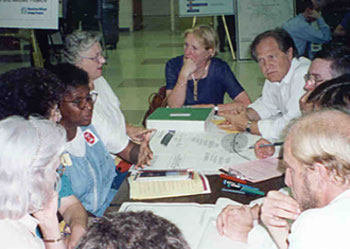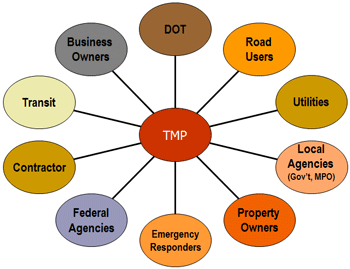Module 3: TMP Coordination
Printable Version [PDF 11.5MB]
PDF files can be viewed with the Acrobat® Reader®.
Contact Information: WorkZoneFeedback@dot.gov
slide 1
Module 3: TMP Coordination


narrator notes
One important element to an effective TMP is "coordination". This module discusses coordination during the TMP development and implementation process, and the parties that should be involved. The module discusses coordination issues that need to be considered and illustrates ways to achieve coordination while developing TMPs.
slide 2
About Module 3
- Stakeholders
- Internal Project Coordination
- Coordinating Multiple Projects
- Interagency Coordination
- Roles and Responsibilities
- TMP Teams
- Exercise
narrator notes
Module 3 discusses stakeholders; internal project coordination; coordinating multiple projects; interagency coordination; roles and responsibilities; and TMP teams. The module concludes with an exercise to help you apply what you have learned.
slide 3
Stakeholders

Coordinate with key stakeholders to identify work zone impact issues to consider and management strategies to address them.
narrator notes
Coordination within and across Agencies and other stakeholders at different stages of the project is crucial for the successful development and implementation of a TMP. Regular meetings are one way to bring all stakeholders together and share the same information in a timely and accurate manner.
The list of stakeholders needs to be carefully thought out and may include Agencies outside the project jurisdiction. For example, if the project is along an evacuation route, then Federal Agencies like the Department of Homeland Security may need to be notified. Another consideration is emergency response. While coordination with emergency responders is always important, if the project is near a hospital additional stakeholders from EMS need to be at the table. The stakeholders list can be added to as the project progresses and new needs arise.
slide 4
Internal Project Coordination
- Alternatives Analysis – Identify work zone impacts and MOT options associated with feasible alternatives. Consider impacts and MOT in selecting the preferred alternative
- Preliminary Engineering – Consider MOT and impacts in sizing structure widths and identifying right-of-way and environmental impacts issues
- Design – Develop phasing and staging plans in consultation with the key stakeholders
- Construction – Maintain close coordination with affected stakeholders as TMP is implemented
narrator notes
The TMP is a living document that needs to be developed and adjusted as the project progresses throughout the various phases and even during construction as major changes take place. The more that work zone impacts are considered as project decisions are made through scoping, alternatives analysis, and design, the greater the chance that solutions to traffic issues can be engineered into the design.
In traditional design/bid/build projects, the goal should be to complete most of the TMP by 60% design. The TMP developed needs to be closely coordinated with key stakeholders throughout all stages of design. During construction the TMP manager needs to work closely with the contractor and affected stakeholders as major updates/changes can result due to post design changes.
For design-build projects, the TMP should be developed within 30-60 days of notice-to-proceed (NTP) and should lay out the procedures and process to be followed in the future design phases.
slide 5
Coordinating Multiple Projects
- Coordinating among multiple projects in the same corridor or region enables Agencies to:
- Effectively manage overall work zone impacts
- Effectively use resources
- Avoid conflicts in roles and responsibilities
- Avoid additional costs
- Avoid conflicts in TTC plans and other future strategies
Oregon Department of Transportation (ODOT) developed a series of corridor-level TMPs under its bridge program, providing an integrated strategy for delivering all required bridge repairs and replacements within a specific corridor.
narrator notes
Coordination among owners of different road projects that can affect each other is crucial to achieve the objectives of any TMP. Poor coordination can result in significant traffic delays, conflicting messages leading to unsafe driving conditions, and a public relations "nightmare" – things that can be avoided with good, proactive coordination.
So it is important to consider the impacts of other concurrent construction projects in the area. The TMP process can help foster this coordination by bringing common stakeholders together. Project schedules can be coordinated and public outreach efforts and traffic management efforts can sometimes be shared across projects.
In some cases, Agencies have developed a regional TMP to help coordinate efforts across all the projects in an area or on a corridor. Oregon DOT's corridor level TMP approach ensures that all the projects and their individual project TMPs within the corridor are integrated, resulting in less conflict and more efficient use of resources.
slide 6
Interagency Coordination
- Critical where project impacts cross jurisdictional lines
- Key Issues:
- Identify Agency personnel
- Define roles and responsibilities
- Have periodic meetings
- Share information
Arizona DOT's Communications and Community Partnerships Division is involved throughout the project through frequent transportation systems management meetings.
narrator notes
Interagency coordination depends on the project size, area, location, and impacts. Often a significant project that is within 25-50 miles of a State border may affect the adjacent State. In large urban areas, where towns are right next to each other, projects done at the local level and permit projects such as utility work particularly require interagency coordination. Honest and open communication is the key to solicit interagency support.
For example, Arizona DOT's Communication Division has frequent management meetings with all Agencies involved in nearby projects.
slide 7
Interagency Coordination
- Utilities
- Transit
- Business/Property Owners
- Emergency Services
- Public Facilities
narrator notes
Coordination with other stakeholders can also be critical at various stages of projects. Other stakeholders may include utility companies, transit providers, businesses, emergency services, and large public facilities such as schools and sports stadiums.
slide 8
Roles and Responsibilities
- Helps with coordination:
- Project related
- Agency wide
- Contact information is documented:
- Key project personnel
- Utilities
- Essential services
- Stakeholders are aware of their roles and responsibilities
narrator notes
Defining roles and responsibilities during TMP development is key to successful project coordination. Roles and responsibilities are defined Agency wide and on a project-by-project basis.
Documenting the contact information and roles and responsibilities in the TMP helps ensure that the stakeholders are aware of their roles and responsibilities. This also helps the TMP Manager or any other TMP-related personnel to easily access the contact information, as needed. This information will also be very helpful in bringing any key project replacement personnel up to date.
In cases where the roles and responsibilities are not well defined and/or all contact information is not available at the beginning stages of the project, the information can be filled in as the project progresses.
slide 9
Roles and Responsibilities
- TMP Development
- Agency/Contractor personnel who have primary responsibility for developing TMP and overall coordination
- TMP Review and Approval
- Agency individual(s) who give final approval to TMP
- TMP Implementation
- Agency and Contractor personnel with primary responsibility to implement the TMP (responsible persons)
narrator notes
The general roles and responsibilities related to TMPs can be thought of in three categories: development, review and approval, and implementation. The development of a TMP involves steps such as consulting with stakeholders, assessing potential work zone impacts, and identifying strategies to help manage the impacts. TMP development may use a team approach, particularly for larger projects.
All TMPs must be approved before being implemented. DOTs have to determine within their job classification, where these responsibilities should be assigned. In some cases, the same person can be used on multiple roles although this should be minimized to avoid a conflict of interest.
TMP implementation requires trained responsible personnel with sufficient knowledge and authority to implement the various elements of the TMP. Both the Agency and the Contractor are required to designate a "responsible person" for this purpose.
slide 10
Roles and Responsibilities—Examples
- Public Information
- Individual responsible for real-time public awareness of work zone issues, as the project advances
- Emergency Contacts
- Stakeholders who need to be kept informed because they provide emergency or critical services.
- Agencies include:
- Local
- Police
- FEMS
- Utilities
- Hospitals
- Schools
- State
- State Highway patrol
- Other State Agencies
- Neighboring State DOTs
- Federal
- Department of Homeland Security
- Local
narrator notes
The list of stakeholders affected by a road project can be extensive. Stakeholders may include those who perform public outreach, provide emergency services, and enforce laws, to name a few. Many times key persons are left out. Often engineers think only within their own jurisdictions, while the project impacts can extend to other Agencies, jurisdictions, and even other States. The key stakeholders roles need to be clearly defined and contact information available for use at a moments notice.
slide 11
TMP Teams
- Forming a TMP team is dependent on project:
- Size
- Location
- Area
- Extent of impacts
- Benefits:
- Effective coordination and work zone management
- Well defined roles and responsibilities
Example
| TMP Development Managers | |
|---|---|
| DOT | Consultant |
| Name/Title: | Name/Title: |
| Unit: | Unit: |
| Phone: | Phone: |
| Email: | Email: |
| Roles and Responsibilities: | |
| TMP Implementation/Monitoring Managers | |
| DOT | Consultant |
| Name/Title: | Name/Title: |
| Unit: | Unit: |
| Phone: | Phone: |
| Email: | Email: |
| Roles and Responsibilities: | |
narrator notes
Forming a TMP team to help with TMP development, coordination, review, and implementation can be helpful. Several States use TMP teams, primarily on significant projects.
A well-balanced team includes a range of appropriate stakeholders. Regular team meetings including the project designer, resident engineer, law enforcement officials, contractor, community representatives, and other stakeholders on major projects can help ensure that work zone management will be effective. A preliminary meeting of this type during the early stage of TMP development helps to identify potential work zone issues early in the process, and to clearly define roles and responsibilities.
The sample table shown here can be useful for documenting the contact information and roles and responsibilities of TMP team members. The table can be modified as the TMP progresses.
slide 12
Exercise
narrator notes
Now that you have completed Module 3, the exercise will provide you with an opportunity to apply what you have learned.
slide 13
Exercise Questions
Turn to page 193 of the Participant Workbook for the exercise
- As the Project Engineer for one of the five construction projects, identify some key issues that could arise if all projects start together, as planned for Fall 2013?
- What are some possible ways to handle coordination?
To access the Participant Workbook, visit: http://www.ops.fhwa.dot.gov/wz/resources/final_rule/tmp_examples/tmp_training/tmp_workbook.pdf.
narrator notes
Please turn to page 193 in Appendix C in the Participant Workbook. After reading the exercise, please answer the questions on this slide.
slide 14
Exercise Discussion
Turn to page 206 of the Participant Workbook for a discussion of the answers
narrator notes
Once you have finished answering the questions, turn to page 206 in the Participant Workbook for a discussion of the exercise answers.
previous | next